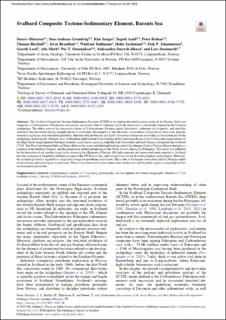| dc.contributor.author | Olaussen, Snorre | |
| dc.contributor.author | Grundvåg, Sten-Andreas | |
| dc.contributor.author | Senger, Kim | |
| dc.contributor.author | Anell, Ingrid | |
| dc.contributor.author | Betlem, Peter | |
| dc.contributor.author | Birchall, Thomas | |
| dc.contributor.author | Braathen, Alvar | |
| dc.contributor.author | Dallmann, Winfried Kurt | |
| dc.contributor.author | Jochmann, Malte Michel | |
| dc.contributor.author | Johannessen, Erik P. | |
| dc.contributor.author | Lord, Gareth Steven | |
| dc.contributor.author | Mørk, Atle | |
| dc.contributor.author | Osmundsen, Per Terje | |
| dc.contributor.author | Smyrak-Sikora, Aleksandra | |
| dc.contributor.author | Stemmerik, Lars | |
| dc.date.accessioned | 2023-07-24T09:01:37Z | |
| dc.date.available | 2023-07-24T09:01:37Z | |
| dc.date.created | 2023-07-15T00:09:32Z | |
| dc.date.issued | 2023 | |
| dc.identifier.issn | 0435-4052 | |
| dc.identifier.uri | https://hdl.handle.net/11250/3081051 | |
| dc.description.abstract | The Svalbard Composite Tectono-Sedimentary Element (SCTSE) is located on the northwestern corner of the Barents Shelf and comprises a Carboniferous–Pleistocene sedimentary succession. Due to Cenozoic uplift, the succession is subaerially exposed in the Svalbard archipelago. The oldest parts of the succession consist of Carboniferous–Permian mixed siliciclastic, carbonate and evaporite, and spiculitic sediments that developed during multiple phases of extension. The majority of the Mesozoic succession is composed of siliciclastic deposits formed in sag basins and continental platforms. Episodes of Late Jurassic and Early Cretaceous contraction are evident in the eastern part of the archipelago and in nearby offshore areas. Differential uplift related to the opening of the Amerasian Basin and the Cretaceous emplacement of the High Arctic Large Igneous Province created a major hiatus spanning from the Late Cretaceous and early Danian throughout the Svalbard CTSE. The West Spitsbergen Fold and Thrust Belt and the associated foreland basin in central Spitsbergen (Central Tertiary Basin) formed as a response to the Eurekan Orogeny and the progressive northward opening of the North Atlantic during the Paleogene. This event was followed by the formation of yet another major hiatus spanning the Oligocene–Pliocene. Multiple reservoir and source-rock units exposed in Svalbard provide analogues to the prolific offshore acreages in the SW Barents Sea, and are important for the de-risking of plays and prospects. However, the archipelago itself is regarded as a high-risk acreage for petroleum exploration. This is due to Paleogene contraction and late Neogene uplift of the western and central parts in particular. There is an absence of mature source rocks in the east, and the entire region is subjected to strict environmental protection. | en_US |
| dc.language.iso | eng | en_US |
| dc.publisher | The Geological Society | en_US |
| dc.rights | Navngivelse 4.0 Internasjonal | * |
| dc.rights.uri | http://creativecommons.org/licenses/by/4.0/deed.no | * |
| dc.title | Svalbard Composite Tectono-Sedimentary Element, Barents Sea | en_US |
| dc.title.alternative | Svalbard Composite Tectono-Sedimentary Element, Barents Sea | en_US |
| dc.type | Peer reviewed | en_US |
| dc.type | Journal article | en_US |
| dc.description.version | publishedVersion | en_US |
| dc.source.journal | Geological Society of London Memoirs | en_US |
| dc.identifier.doi | 10.1144/M57-2021-36 | |
| dc.identifier.cristin | 2162383 | |
| cristin.ispublished | true | |
| cristin.fulltext | original | |
| cristin.qualitycode | 1 | |

